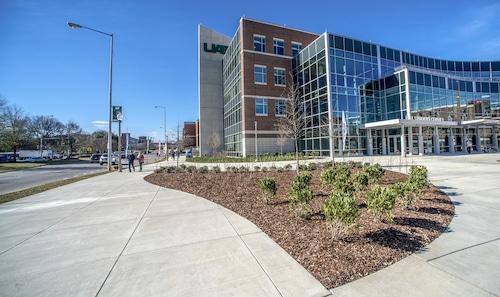For the first time, Alabama has released a plan to dramatically cut the state’s greenhouse gas emissions over the next 25 years, although the state will have to compete for federal dollars to pay for the effort.
The plan includes more solar power with battery storage, energy-efficiency building retrofits, recycling upgrades, electric vehicles for municipal fleets and buses, and a carbon capture and storage plan to trap emissions from smokestacks and pump them deep underground.
Now it’s a waiting game to see which projects can get federal funding.
The Alabama Department of Environmental Management submitted the Preliminary Climate Action Plan to the U.S. Environmental Protection Agency earlier this month, detailing 13 projects that could cut Alabama’s greenhouse gas emissions by an estimated 67.5 million tons over the next 25 years.
That’s about half the estimated total amount of greenhouse gases Alabama generated in 2021 (135.3 million tons), according to a detailed inventory of the largest sources of greenhouse gas emissions included in the plan.
Environmental advocates say Alabama’s initiative to develop a plan is an important step toward reducing air pollution that can cause climate change and negative health impacts to people who breathe polluted air.
“This is the first time Alabama has had a statewide inventory and a roadmap [to reduce climate pollution],” said Alys Campaigne, the Southern Environmental Law Center’s Climate Project Leader. “That’s a big deal in and of itself.”
The EPA’s Climate Pollution Reduction Grants program is part of the federal Inflation Reduction Act of 2022, which will include $4.6 billion to fund greenhouse gas reduction projects across the country.
Forty five states, plus the District of Columbia, Puerto Rico, and dozens of large metropolitan areas submitted plans as a first step toward applying for federal funding. Projects must be included in one of the plans to be eligible for funding, but not all projects will get funding.
Alabama’s plan alone included more than $1 billion in funding requests for $4.6 billion in funding nationwide.
So what’s in Alabama’s plan? Here are the 13 projects and how they would reduce climate pollution:
Carbon Capture and Storage at International Paper
The largest and likely the most controversial project included in the plan is a billion-dollar project to capture emissions from the smokestacks at International Paper’s Pine Hill Mill in Wilcox County. Those emissions would then be liquified and pumped underground, where they can’t escape into the atmosphere.
Though the total project price tag is expected to be over $1 billion, the proposal said the applicants would only seek $500 million in IRA funding. The Alabama Forestry Commission and International Paper would work together on the project.
The project description estimates that this would prevent 43.8 million metric tons of CO2 pollution by 2050, by far the largest amount of any of Alabama’s proposals.
However, carbon capture and storage is a controversial method of reducing greenhouse gases.
The World Resources Institute notes that while carbon sequestration is often considered a vital part of any plan to reduce global emissions, “There are not many examples to date of its successful application, and several high-profile projects have been abandoned or shuttered.”
Enhanced recycling in Montgomery
The plan includes a $110 million project to improve the RePower South recycling center in Montgomery to accept more recyclables and divert more trash from landfills, including an organic composting component.
RePower accepts the waste from Montgomery, Prattville, Dothan, Millbrook, Maxwell Airforce Base, Fort Walton, Vestavia Hills, Hoover, Pelham, Mountain Brook, and Trussville, sorting the recyclable materials out so customers don’t have to.
The project would save an estimated 3.7 million tons of greenhouse gases by 2050.
Solar irrigation pumps in rural Alabama
This project would use $8.13 million to install solar and battery installations to power water pumps and irrigation pivots in rural areas of the Black Belt that don’t have traditional power lines. The project could reduce farming costs in remote locations and cut transport costs by growing more produce locally in Alabama.
The project would save an estimated 62,000 tons of CO2 by 2050.
Low-carbon cement factory in Leeds
This $21.6 million project would retrofit the Heidelberg Materials cement plant in Leeds to produce low-carbon cement instead of traditional Portland cement to provide dramatic reductions in greenhouse gases.
Heidelberg Materials would contribute $2.4 million toward the retrofit under the proposal.
The project would result in an annual reduction of 780,000 tons of CO2, totaling 18.7 million tons by 2050.
Low-carbon, low-temperature asphalt for Alabama’s highways
The Alabama Department of Transportation proposed building a cold-temperature asphalt recycling facility and a warm-mix asphalt that can be mixed at cooler temperatures, saving energy.
The project would cost $63.8 million and cut emissions by an estimated 303,727 tons by 2050.
Huntsville EV fleet and microgrid storage
Huntsville Utilities had a two-phase proposal to convert some of its fleet vehicles to electrics and to add grid-scale battery storage to the electric grid. Two batteries totaling 10 MW would be added to the grid in strategic locations to reduce the strain during peak demand hours.
The project totals $19.47 million and would cut emissions by 72,875 tons.
UAB electric buses and solar-powered parking deck
The plan includes a proposal from UAB to electrify its fleet of 22 campus buses and 30 other fleet vehicles and to build a 94-kilowatt solar array on a new parking deck.
The project would cost $4.3 million and cut emissions by 15,676 tons by 2050.

Major upgrades for Alabama’s community colleges
The Alabama Community College System submitted a proposal for a $90.5 million project that would fund solar power, electric bus service, and energy-efficiency building renovation projects at all 24 campuses in the state.
The project would cut emissions by an estimated 46,143 tons by 2050.
Parrish sustainability project
One of Alabama’s historic coal towns, Parrish, has proposed a project to add electric vehicle charging stations, make energy-efficiency renovations to town-owned buildings, and install solar panels with battery storage to provide clean energy for the town.
The project would cost just over $14 million and cut emissions by 71,592 tons by 2050.
TVA efficiency and distribution project
Alabama is working with Tennessee and Mississippi on a proposal to implement energy efficiency measures for customers and more efficient transmission lines for TVA customers in those three states.
The project would cost an estimated $80 million and would avoid 137,600 tons of emissions by 2050.
Energy upgrades and EV charging stations at businesses across the state
The Alabama Department of Economic and Community Affairs proposed a $20 million project to fund energy efficiency upgrades at schools, churches and community buildings in low-income and disadvantaged communities across the state, and create grants to fund installation of EV charging stations at private businesses.
The project would cut an estimated 273,628 tons of emissions.
Shore power for container and cruise ships
ADECA also proposed building electric charging stations for massive ships at the Port of Mobile and the Mobile Cruise Terminal.
The $60 million project would allow ships to recharge at port, electrify other operations at the docks, and offer incentives to commercial entities that use zero-emission equipment. The project would avoid an estimated 63,680 tons of emissions by 2050.
Incentives for EV adoption
Finally, a $20 million project proposed by ADECA would offer incentives to install electric charging infrastructure across the state and to convert fleet vehicles from gas-powered to electric.
The project is estimated to reduce emissions by 273,552 tons by 2050.
What’s next?
Altogether, these projects would reduce emissions by an estimated 67.5 million tons by 2050, but not all will be funded.
While ADEM assembled the preliminary plan, it did not evaluate the specifics of each proposal, which came from government entities like a state agency, university or municipality. The projects included in Alabama’s plan are eligible for federal funding through the EPA.
The deadline for the first round of project applications is April 1.
You can read Alabama’s full Preliminary Climate Action Plan here.











